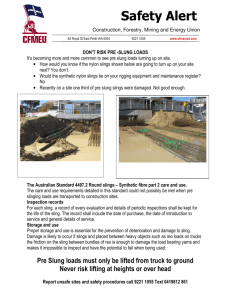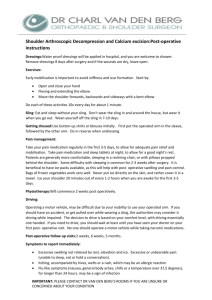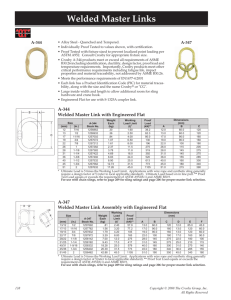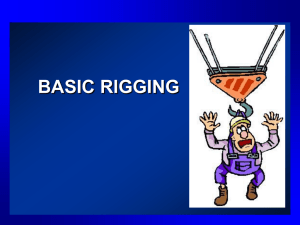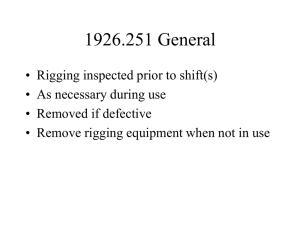Cranes, Slings and You
advertisement
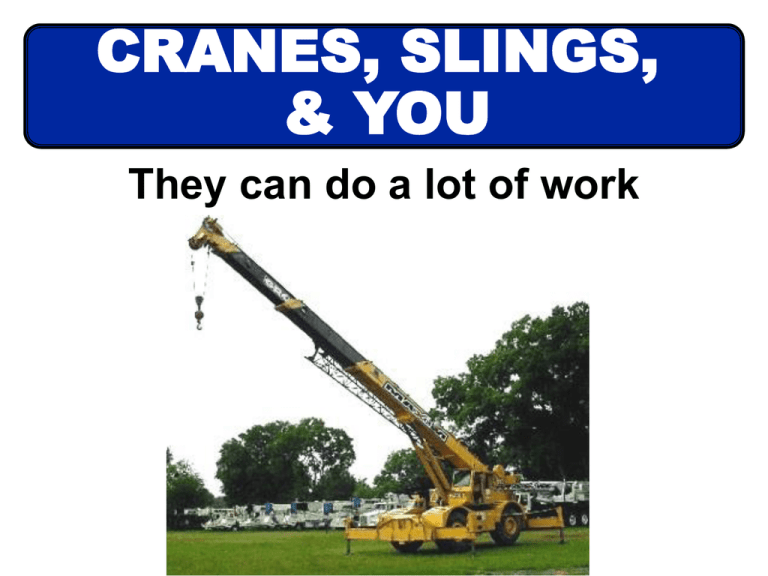
CRANES, SLINGS, & YOU They can do a lot of work CRANES, SLINGS, & YOU They can do a lot of damage Idle Cranes Cranes that have been idle, must be inspected and tested before being placed back in service using the criteria that applies to periodic inspection. Special attention should be given to the hook, lifting chain and wire rope. Review the manufacturers specific inspection requirements! Altered Cranes Cranes that have been altered or repaired must be inspected and tested. If load sustaining parts are altered or repaired, a load test should be conducted to verify the rated load capacity of the crane. Report issued by a qualified person and kept on file. Load Testing When load testing, the test load cannot exceed 125 percent of the rated load. Hoists & cranes should be operated a number of times at various positions. Report issued by testing organization giving the conditions under which system was load tested. Preventive Maintenance 1. 2. 3. 4. 5. 6. 7. 8. 9. Clean & lube wire rope & chain Adjusting brakes Checking & filling gear cases levels Replacing any contaminated oils Lube bearings, gears, pinions, linkages, & shafts Adjusting operation of limit switches Clean & replace pitted/burned electrical contacts Cleaning or replacing air & fluid filters Inspecting all controls & warning systems General Pre-Op Test 1. Disconnects are known before any test 2. Get help if you’re not familiar with the cranes 3. Follow manufacturers recommendations 4. Follow Checklist 5. Inspect electrical controls 6. Check for obstructions in crane’s travel path 7. Test proper operation of controls 8. Observe for smooth operation of components 9. Never unwind spool completely 10.Check upper & lower limit switches Hook Pre-op Test 1. 2. 3. 4. 5. 6. Replace if deformed or cracked Check for proper function of safety latch Inspect for twists from plane of unbent hook Check for proper swivel Hook repair is not recommended Emergency hook repair must be performed only under competent supervision 7. After any hook repairs, hook must be load tested before being returned to normal service Rope Pre-op Test 1. Reduction in rope diameter 2. Broken or worn outside wires 3. Corroded or broken wires at end of connections 4. Severe kinking, crushing, cutting or unstranding 5. Corroded, cracked, bent, worn, or improperly applied end connections Lockout-Tagout 1. Review individual crane requirements 2. Integrate lockout & maintenance requirements 3. Lockout-tagout training 4. Written program established & reviewed 5. Ask manufacturer for lockout device recommendations 6. Devices not always interchangeable between different cranes DANGER LOCKED OUT DON’T OPERATE This Lock/Tag may only be removed by NAME: __________ DEPT : __________ COMPLETION DATE: ___________ TIME: ____________ Crane Safety Basics Never allow a co-worker between a fixed object and a load! DANGER WORKING CRANES 2 TON Fatalgram The feeder was lowered to the ground, resting in an unsecured position. The feeder rolled on its side, pinning the victim against the wall of an adjacent control booth. Fatalgram The employee was in the process of loading a conveyor onto the trailer of his truck using the truck's crane. The cable attached to the conveyor slipped off the hook of the crane causing the conveyor to bounce off the trailer and crush the victim who was standing between the crane and the trailer. He died from crushing injuries. Safe Working Radius Know the safe travel radius of the crane. Contact with electrical sources or other hazards can result in catastrophic consequences. Load Chart Crane Safety Basics Even when properly trained, equipment properly maintained, & employees work in a safe manner, accidents can still occur because crane operations are dependant on mechanical devices that can fail. The results can be catastrophic. You are the only controlling influence that can minimize the hazard. Your life literally is in your own hands! Operator Requirements 1. 2. 3. 4. 5. 6. 7. 8. 9. No history of unsafe acts in workplace Mature & safe attitude Ability to react quickly in an emergency Drug & alcohol free Good depth perception Good hearing and vision Thoroughly trained Understand lift requirements No medication that will interfere with operation Safe Practices 1. Test controls & brakes at start of shift 2. Don’t operate unsafe cranes or hoists 3. Test brakes by a short lift to ensure control 4. Move loads only after being signaled by designated, qualified signaler Safe Practices 1. Never carry loads over anyone 2. Never carry loads past anyone 3. Signalers in line-of-sight of operator 4. No riders on loads or hooks 5. No unauthorized person operating crane 6. Lockout before maintenance or repairs 7. Frequently inspect cranes Safe Practices 1. Hook directly over load before lifting 2. Document & maintain inspection records 3. Check warning devices & signals 4. Signalers must watch load 5. Operators must watch signalers 6. Know travel path in advance of lift 7. Know where to set down load 8. Will new location support weight Fatalgram The employee was using a truck equipped with a hydraulic boom to position a tire on the hub of a caterpillar loader. The tire fell off the hook and struck the employee on his head and neck. Fatalgram Three steel plates weighing nearly 6,000 pounds were tied together by one nylon strap. They were lifted about 5 feet by a crane in order to slide a second strap around them. The truck driver walked under the suspended load, and at that moment, the strap around the steel plates broke. The plates fell striking the victim. He died from head injuries. Fatalgram A cement take-up pulley weight for a conveyer was being lifted into position by a crane. To lift the weight, straps were attached to four pins that had been set into the cement weight. The employee was riding on the 3,000 pound weight as it was being lifted. One of the pins pulled out of the weight causing the employee to lose his balance and fall 35 feet to the ground. He died from sustained injuries. Signaler Safe Practices 1. Only one person is designated signaler 2. Maintain line-of-sight with operator 3. Operator acknowledges every signal 4. Stop operation if comprehension is lost 5. Operators must watch signalers 6. Plan in advance where load is going 7. Will new location will support the weight Leaving or Parking 1. Raise hooks to limit switches 2. Place controls in “off” position 3. Place main power switch in “off” position 4. Visual check for dangerous conditions 5. Report defects immediately 6. Tagout defective equipment immediately 7. Report cranes not in operation 8. Follow manufacturer’s recommendations. Lifting Factors 1. Size, weight, & center of gravity of load 2. Number of sling legs 3. Angle sling makes with horizontal line 4. Rated capacity of sling 5. History of care & usage of sling Size, Weight, & Center of Gravity 1. Crane hook must be directly above center of gravity 2. If crane hook is too far to one side of center of gravity, dangerous tilting and unequal stress to sling leg will result Capacity of Sling 1. Rated capacity varies depending upon type of sling, size of sling, & type of hitch 2. Consult with manufacturer 3. Older slings must be used with additional caution 4. Sling charts based on new sling usage. Care & Usage 1. Mishandling & misuse of slings are leading cause of sling-related accidents 2. Proper care essential for maximum service & safety 3. Always protect slings with cover saddles, burlap padding or wood blocking to prevent sharp bends & cutting edges. Estimating Load Weight 1. Use a Dynamometer 2. Check shipping papers 3. Check nomenclature plates 4. Use industry standard tables or charts 5. Consult equipment manufacturer 6. Estimate using weights of similar loads 7. Never lift based on a guess 8. Stay within 50% of cranes rated capacity when estimating loads Rigging & Slings 1. Chains 2. Wire Rope 3. Fiber Rope 4. Synthetic Web 5. Cargo Nets. Each type has advantages and disadvantages! Rigging & Slings Consult with manufacturer concerning load capacities, usage methods, restrictions and other pertinent data for specific types of slings Rules for Slings 1. Never load in excess of rated capacity 2. Never use a damaged sling 3. Never pull sling from a suspended load 4. Never shorten with knots 5. Suspended loads clear of everyone 6. Suspended loads clear of obstructions 7. Hands & fingers clear of loads 8. Protect slings from sharp edges of load 9. Think before you affect a load. Wire Rope Inspection Remove from service if: 1. 10 distributed broken wires 2. Five broken wires on one strand 3. Kinking, crushing, or bird caging 4. Evidence of heat damage 5. End attachments cracked, deformed, or worn 6. Hooks opened > 15% of the normal throat opening or twisted > 10% Chain Inspection Remove from service if: 1. Defective or questionable welds 2. Bending or elongation of chain links 3. Cracked or deformed links 4. Missing or removed identification tags 5. End attachments cracked, deformed, worn 6. Other suspected unsafe conditions Web Sling Inspection Remove from service if: 1. Acid or caustic burns 2. Age deterioration (drying/cracking) 3. Melting or charring of sling surface 4. Snags, tears or cuts exposure of colored thread 5. Missing or removed identification tags 6. Other suspected unsafe conditions After The Lift 1. Clean sling 2. Check for damage 3. Follow proper storage rules 4. Leave in good condition for next lift 5. Report damaged or defective slings 6. Follow proper disposal or replacement procedures Slings Storage 1. Dry environment, out of sunlight 2. Off floor or ground 3. Hung from hooks to prevent tangling and easy access 4. Away from electrical sources 5. By type - don’t mix steel chain slings with synthetics 6. In a controlled area Sling Angles Consult with the sling manufacturer concerning how sling angles affect load capacities for different types of slings. 1000lb 1000lb 1000lb Sling Angles 1. Angle of sling affects sling load capacity 2. Greater sling angle, greater stress 3. Multiple sling affects load capacity 4. Type of sling used is a factor 5. Consult with manufacturer for proper usage. 1000lb 1000lb 1000lb Two Slings The use of two 500lbs slings, each supporting the same amount of weight and having the same support angle results in equal distribution of the load weight. 500lbs 1000lb 0 Angle Sling Angles Sling Angle With Vertical 0 5 10 15 20 25 30 35 40 45 50 55 60 80 Stresses Per Sling Leg 1000 lbs Total Load 500 502 508 518 532 552 577 610 653 707 778 872 1000 2880 577lbs 577lbs 30 1000lb 30 Angle Sling Angles 707lbs 707lbs 1000lbs 1000lb 45 Angle 1000lbs 1000lb 60 Angle Sling Angles The carrying capacity decreases as the spread between the slings increases. To determine the capacity of each sling in a bridle hitch: A B Measure the distance on one sling for the same number of units as the capacity of the sling in tons (Distance A). 2. Measure the vertical distance from the point located in to the load in tons. (Distance B). 3. The number of units in this vertical distance (B) is the working load for the sling. 1. Sling Angles A B A = 2 ft. (or any unit) (2 Ton Sling Capacity) B = 1.5 ft. Working Capacity of Each Sling = 1.5 Tons Note: The individual sling capacity must be more than half of the total load weight Protecting Slings Protect slings against sharp edges HAND SIGNALS Hoist load: 1. Forearm vertical 2. Forefinger pointing up 3. Move hand in small horizontal circular motion HAND SIGNALS Lower load: 1. Arm downward 2. Forefinger pointing down 3. Move hand in small horizontal circular motion HAND SIGNALS Boom Travel: 1. Arm extended forward 2. Hand open and slightly raised 3. Make pushing motion in the direction of travel HAND SIGNALS Stop: 1. Arm extended 2. Palm down 3. Move arm sideways, rapidly back & forth HAND SIGNALS Emergency stop: 1. Both arms extended 2. Palms down 3. Move both arms sideways rapidly back & forth Protective Equipment 1. Appropriate for the particular hazards 2. Maintained in good condition 3. Properly stored when not in use 4. Kept clean, fully functional, and sanitary
